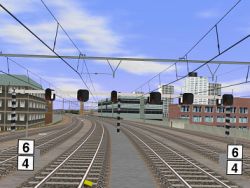The study made use of eye-tracking technology and simulation research, methods that were relatively new to ProRail. NLR, on the other hand, has extensive experience in applying these systems to study pilots’ behaviour, with a view to creating a better and safer working environment and procedures.
In this joint project, NLR assisted ProRail in the acquisition of eye-tracking equipment and the application of this equipment in a simulator belonging to NS (Dutch Railways). ProRail wanted to know whether eye-tracking, combined with other research methods used by NLR, would be useful in addressing specific research issues. For instance, how do drivers react to a new signal, bridge or station design? Or what do drivers look at when approaching a portal signal.
As a case study, research was conducted using a signal portal between Eindhoven Beukenlaan Station and Eindhoven Central Station, where, in the past, various trains had failed to respond to a red light. The research monitored the behaviour of train drivers passing the signal (both in a simulator and in reality).
ProRail is very enthusiastic about the insight this research method have given into drivers’ behaviour. Furthermore, the method enables ProRail to conduct preemptive tests into driver’ responses to new developments on and around the tracks. A brief follow-up study looked at how drivers travelling at high speed aboard the Thalys train perceive signals and other signage.
Train drivers look out of the window to gather information about their surroundings. Pilots read similar information on displays. Despite this difference, the methods used to map pilots’ behaviour can also be used to study train drivers’ behaviour. ProRail and NLR teamed up to study this further.

